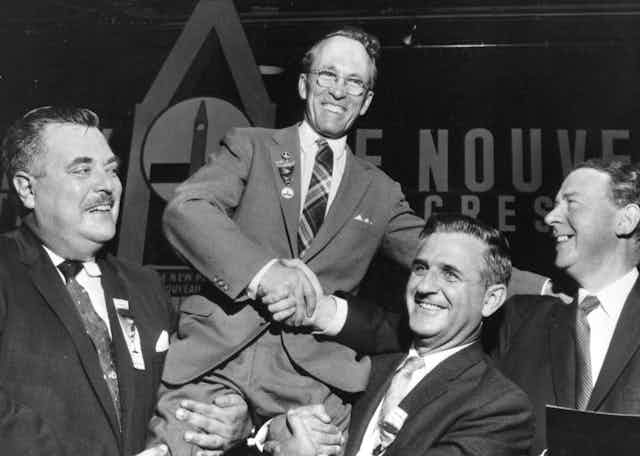The New Democratic Party turns 60 this summer. Throughout its entire history, media pundits and political opponents have lambasted the party as the puppet of organized labour. This characterization, however, no longer holds water — if it ever did.
The widely held yet deeply flawed assumption that the NDP is the political arm of Canada’s labour movement has been held up by voices on both the left and right of the political spectrum. The history and reality of the party-union relationship, however, is much more complex.
The Canadian Labour Congress played a key role in officially launching the NDP in August 1961 as a new progressive electoral vehicle for working-class voters.
The party’s pro-union architects anticipated that the creation of the NDP would squeeze out the Liberals and establish the party as the primary alternative to the Conservatives. However, that much-hoped-for electoral realignment has never really materialized at the federal level.
From the start, union leaders struggled to convince their members to support the NDP. That created a dynamic characterized by close relations between union and party leaders without an equivalent relationship at the rank-and-file level.

Formal union affiliation to the party peaked in 1963 at just 14.6 per cent of union members, before facing a steady decline over the next few decades.
And union members, despite the best efforts of some labour leaders, have never formed a reliable and consistent NDP voting bloc.
Why aren’t unions loyal to the NDP?
Although important segments of the union movement continue to hold special status as key party stakeholders, and even though unions continue to be an important source of NDP candidates, organized labour’s formal ties and influence over the party have diminished considerably in recent decades.
How do we account for this? There are several contributing factors.
First, the labour movement has undergone significant changes since the 1960s. The NDP was really the creation of private sector industrial unions that dominated the labour movement in the immediate post-Second World War period. However, the rise of public sector unionism has significantly altered the composition of the labour movement and, by extension, its political priorities.

While the NDP does maintain some ties with specific public sector unions, the uneven track record of provincial NDP governments as employers has generally undermined the development of reliable electoral alliances. The ghost of Ontario NDP Premier Bob Rae’s infamous anti-union wage restraint legislation still looms large.
Second, the federal NDP’s lack of electoral success has undermined its union ties. Like most groups that try to influence the outcome of election campaigns, unions must concern themselves with the benefits, but also the drawbacks, of supporting a party that may share their values but can’t get voted into power.
The third factor is financial. Historically, unions were an important source of funding for the party until their donations were severely curbed and then altogether banned by federal campaign finance legislation between 2004 and 2006. This severing of financial ties undermined the party-union relationship by limiting the direct ways unions could fund the party’s activities and, by extension, influence its priorities.
All of these factors have led to weaker ties between organized labour and the NDP.
While the Canadian Labour Congress is still officially on record as supporting the NDP, the views of its affiliates and other unions are decidedly mixed. Some continue to work closely with the party, while most have sought alternative political strategies, including issue-based third-party campaigns and tactical endorsements of rival party candidates, usually as part of union-led, anti-Conservative strategic voting campaigns.

What’s next?
The changing dynamic between the NDP and unions has shifted the landscape of labour politics in Canada, but in unanticipated ways.
At the turn of the 21st century, loosening ties to the NDP was promoted by some unions as the key to developing a more independent and left-wing brand of working-class politics. However, it appears the opposite has occurred, evident in the widespread support among unions for anti-Conservative strategic voting — a tactic that has primarily benefited the federal Liberals.
The NDP’s perceived grip on union voters seems more tenuous than ever as parties jockey for the votes of union members with populist cultural and economic appeals and targeted commitments to pursue pro-union initiatives.
The implications of a weakened NDP-union relationship for the future of labour and working-class politics in Canada are significant. If unions are more likely to pursue independent political strategies, will the NDP show less interest in championing labour movement priorities in the House of Commons?
NDP Leader Jagmeet Singh’s recent push to woo small business owners may provide a clue to the party’s evolving priorities.
Whether the labour movement’s ties to the NDP will continue to weaken remains to be seen, but there can be no doubt that the political muscle of unions that helped to launch the NDP in 1961 was never that strong in the first place. Even worse for the party, it’s atrophied considerably over the course of the last 60 years.

